Wangchunshu Zhou
MemEvolve: Meta-Evolution of Agent Memory Systems
Dec 21, 2025Abstract:Self-evolving memory systems are unprecedentedly reshaping the evolutionary paradigm of large language model (LLM)-based agents. Prior work has predominantly relied on manually engineered memory architectures to store trajectories, distill experience, and synthesize reusable tools, enabling agents to evolve on the fly within environment interactions. However, this paradigm is fundamentally constrained by the staticity of the memory system itself: while memory facilitates agent-level evolving, the underlying memory architecture cannot be meta-adapted to diverse task contexts. To address this gap, we propose MemEvolve, a meta-evolutionary framework that jointly evolves agents' experiential knowledge and their memory architecture, allowing agent systems not only to accumulate experience but also to progressively refine how they learn from it. To ground MemEvolve in prior research and foster openness in future self-evolving systems, we introduce EvolveLab, a unified self-evolving memory codebase that distills twelve representative memory systems into a modular design space (encode, store, retrieve, manage), providing both a standardized implementation substrate and a fair experimental arena. Extensive evaluations on four challenging agentic benchmarks demonstrate that MemEvolve achieves (I) substantial performance gains, improving frameworks such as SmolAgent and Flash-Searcher by up to $17.06\%$; and (II) strong cross-task and cross-LLM generalization, designing memory architectures that transfer effectively across diverse benchmarks and backbone models.
Memory in the Age of AI Agents
Dec 15, 2025Abstract:Memory has emerged, and will continue to remain, a core capability of foundation model-based agents. As research on agent memory rapidly expands and attracts unprecedented attention, the field has also become increasingly fragmented. Existing works that fall under the umbrella of agent memory often differ substantially in their motivations, implementations, and evaluation protocols, while the proliferation of loosely defined memory terminologies has further obscured conceptual clarity. Traditional taxonomies such as long/short-term memory have proven insufficient to capture the diversity of contemporary agent memory systems. This work aims to provide an up-to-date landscape of current agent memory research. We begin by clearly delineating the scope of agent memory and distinguishing it from related concepts such as LLM memory, retrieval augmented generation (RAG), and context engineering. We then examine agent memory through the unified lenses of forms, functions, and dynamics. From the perspective of forms, we identify three dominant realizations of agent memory, namely token-level, parametric, and latent memory. From the perspective of functions, we propose a finer-grained taxonomy that distinguishes factual, experiential, and working memory. From the perspective of dynamics, we analyze how memory is formed, evolved, and retrieved over time. To support practical development, we compile a comprehensive summary of memory benchmarks and open-source frameworks. Beyond consolidation, we articulate a forward-looking perspective on emerging research frontiers, including memory automation, reinforcement learning integration, multimodal memory, multi-agent memory, and trustworthiness issues. We hope this survey serves not only as a reference for existing work, but also as a conceptual foundation for rethinking memory as a first-class primitive in the design of future agentic intelligence.
O-Mem: Omni Memory System for Personalized, Long Horizon, Self-Evolving Agents
Nov 18, 2025
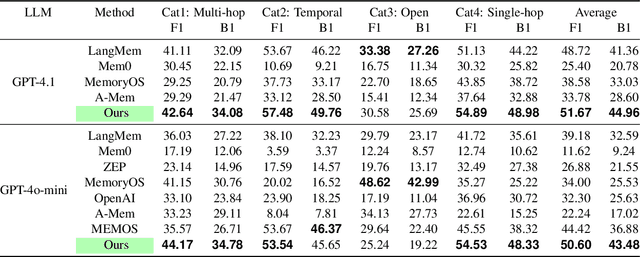
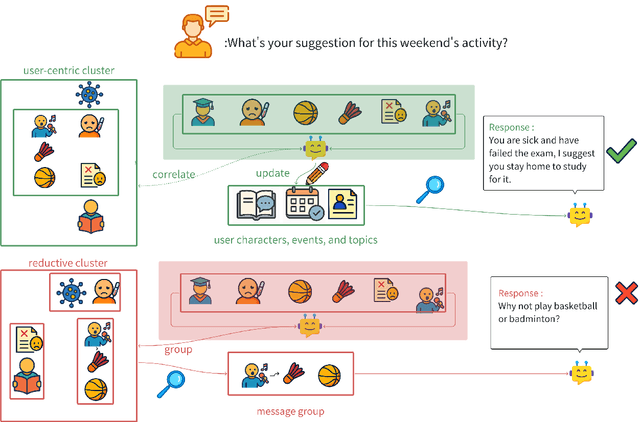

Abstract:Recent advancements in LLM-powered agents have demonstrated significant potential in generating human-like responses; however, they continue to face challenges in maintaining long-term interactions within complex environments, primarily due to limitations in contextual consistency and dynamic personalization. Existing memory systems often depend on semantic grouping prior to retrieval, which can overlook semantically irrelevant yet critical user information and introduce retrieval noise. In this report, we propose the initial design of O-Mem, a novel memory framework based on active user profiling that dynamically extracts and updates user characteristics and event records from their proactive interactions with agents. O-Mem supports hierarchical retrieval of persona attributes and topic-related context, enabling more adaptive and coherent personalized responses. O-Mem achieves 51.67% on the public LoCoMo benchmark, a nearly 3% improvement upon LangMem,the previous state-of-the-art, and it achieves 62.99% on PERSONAMEM, a 3.5% improvement upon A-Mem,the previous state-of-the-art. O-Mem also boosts token and interaction response time efficiency compared to previous memory frameworks. Our work opens up promising directions for developing efficient and human-like personalized AI assistants in the future.
Towards Faithful and Controllable Personalization via Critique-Post-Edit Reinforcement Learning
Oct 21, 2025Abstract:Faithfully personalizing large language models (LLMs) to align with individual user preferences is a critical but challenging task. While supervised fine-tuning (SFT) quickly reaches a performance plateau, standard reinforcement learning from human feedback (RLHF) also struggles with the nuances of personalization. Scalar-based reward models are prone to reward hacking which leads to verbose and superficially personalized responses. To address these limitations, we propose Critique-Post-Edit, a robust reinforcement learning framework that enables more faithful and controllable personalization. Our framework integrates two key components: (1) a Personalized Generative Reward Model (GRM) that provides multi-dimensional scores and textual critiques to resist reward hacking, and (2) a Critique-Post-Edit mechanism where the policy model revises its own outputs based on these critiques for more targeted and efficient learning. Under a rigorous length-controlled evaluation, our method substantially outperforms standard PPO on personalization benchmarks. Personalized Qwen2.5-7B achieves an average 11\% win-rate improvement, and personalized Qwen2.5-14B model surpasses the performance of GPT-4.1. These results demonstrate a practical path to faithful, efficient, and controllable personalization.
AgenTracer: Who Is Inducing Failure in the LLM Agentic Systems?
Sep 04, 2025Abstract:Large Language Model (LLM)-based agentic systems, often comprising multiple models, complex tool invocations, and orchestration protocols, substantially outperform monolithic agents. Yet this very sophistication amplifies their fragility, making them more prone to system failure. Pinpointing the specific agent or step responsible for an error within long execution traces defines the task of agentic system failure attribution. Current state-of-the-art reasoning LLMs, however, remain strikingly inadequate for this challenge, with accuracy generally below 10%. To address this gap, we propose AgenTracer, the first automated framework for annotating failed multi-agent trajectories via counterfactual replay and programmed fault injection, producing the curated dataset TracerTraj. Leveraging this resource, we develop AgenTracer-8B, a lightweight failure tracer trained with multi-granular reinforcement learning, capable of efficiently diagnosing errors in verbose multi-agent interactions. On the Who&When benchmark, AgenTracer-8B outperforms giant proprietary LLMs like Gemini-2.5-Pro and Claude-4-Sonnet by up to 18.18%, setting a new standard in LLM agentic failure attribution. More importantly, AgenTracer-8B delivers actionable feedback to off-the-shelf multi-agent systems like MetaGPT and MaAS with 4.8-14.2% performance gains, empowering self-correcting and self-evolving agentic AI.
TreePO: Bridging the Gap of Policy Optimization and Efficacy and Inference Efficiency with Heuristic Tree-based Modeling
Aug 24, 2025



Abstract:Recent advancements in aligning large language models via reinforcement learning have achieved remarkable gains in solving complex reasoning problems, but at the cost of expensive on-policy rollouts and limited exploration of diverse reasoning paths. In this work, we introduce TreePO, involving a self-guided rollout algorithm that views sequence generation as a tree-structured searching process. Composed of dynamic tree sampling policy and fixed-length segment decoding, TreePO leverages local uncertainty to warrant additional branches. By amortizing computation across common prefixes and pruning low-value paths early, TreePO essentially reduces the per-update compute burden while preserving or enhancing exploration diversity. Key contributions include: (1) a segment-wise sampling algorithm that alleviates the KV cache burden through contiguous segments and spawns new branches along with an early-stop mechanism; (2) a tree-based segment-level advantage estimation that considers both global and local proximal policy optimization. and (3) analysis on the effectiveness of probability and quality-driven dynamic divergence and fallback strategy. We empirically validate the performance gain of TreePO on a set reasoning benchmarks and the efficiency saving of GPU hours from 22\% up to 43\% of the sampling design for the trained models, meanwhile showing up to 40\% reduction at trajectory-level and 35\% at token-level sampling compute for the existing models. While offering a free lunch of inference efficiency, TreePO reveals a practical path toward scaling RL-based post-training with fewer samples and less compute. Home page locates at https://m-a-p.ai/TreePO.
OS Agents: A Survey on MLLM-based Agents for General Computing Devices Use
Aug 06, 2025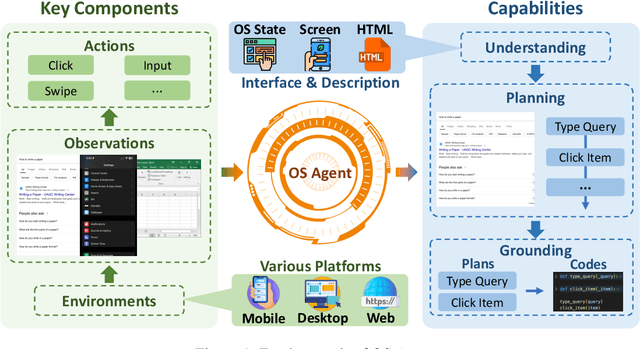
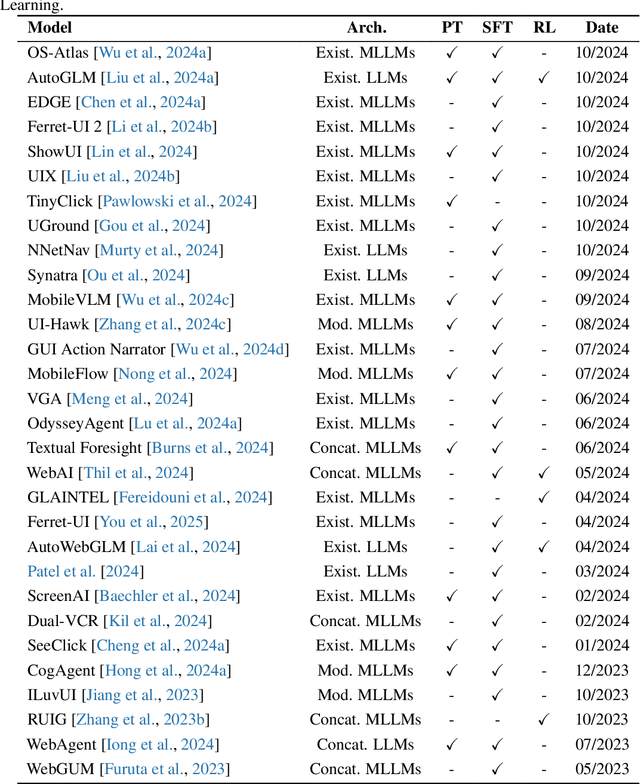
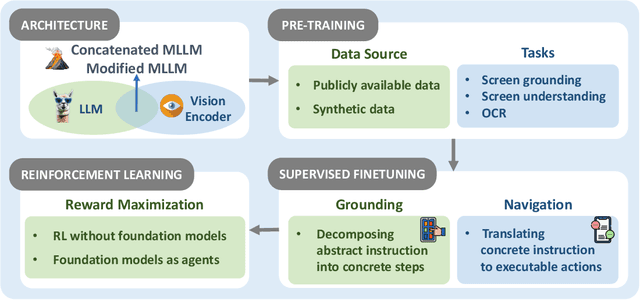
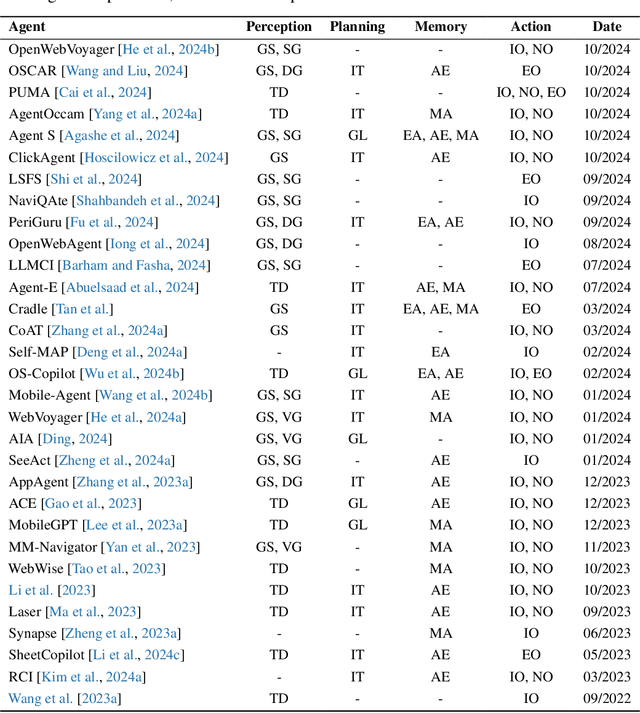
Abstract:The dream to create AI assistants as capable and versatile as the fictional J.A.R.V.I.S from Iron Man has long captivated imaginations. With the evolution of (multi-modal) large language models ((M)LLMs), this dream is closer to reality, as (M)LLM-based Agents using computing devices (e.g., computers and mobile phones) by operating within the environments and interfaces (e.g., Graphical User Interface (GUI)) provided by operating systems (OS) to automate tasks have significantly advanced. This paper presents a comprehensive survey of these advanced agents, designated as OS Agents. We begin by elucidating the fundamentals of OS Agents, exploring their key components including the environment, observation space, and action space, and outlining essential capabilities such as understanding, planning, and grounding. We then examine methodologies for constructing OS Agents, focusing on domain-specific foundation models and agent frameworks. A detailed review of evaluation protocols and benchmarks highlights how OS Agents are assessed across diverse tasks. Finally, we discuss current challenges and identify promising directions for future research, including safety and privacy, personalization and self-evolution. This survey aims to consolidate the state of OS Agents research, providing insights to guide both academic inquiry and industrial development. An open-source GitHub repository is maintained as a dynamic resource to foster further innovation in this field. We present a 9-page version of our work, accepted by ACL 2025, to provide a concise overview to the domain.
IFEvalCode: Controlled Code Generation
Jul 30, 2025Abstract:Code large language models (Code LLMs) have made significant progress in code generation by translating natural language descriptions into functional code; however, real-world applications often demand stricter adherence to detailed requirements such as coding style, line count, and structural constraints, beyond mere correctness. To address this, the paper introduces forward and backward constraints generation to improve the instruction-following capabilities of Code LLMs in controlled code generation, ensuring outputs align more closely with human-defined guidelines. The authors further present IFEvalCode, a multilingual benchmark comprising 1.6K test samples across seven programming languages (Python, Java, JavaScript, TypeScript, Shell, C++, and C#), with each sample featuring both Chinese and English queries. Unlike existing benchmarks, IFEvalCode decouples evaluation into two metrics: correctness (Corr.) and instruction-following (Instr.), enabling a more nuanced assessment. Experiments on over 40 LLMs reveal that closed-source models outperform open-source ones in controllable code generation and highlight a significant gap between the models' ability to generate correct code versus code that precisely follows instructions.
A Survey on Latent Reasoning
Jul 08, 2025


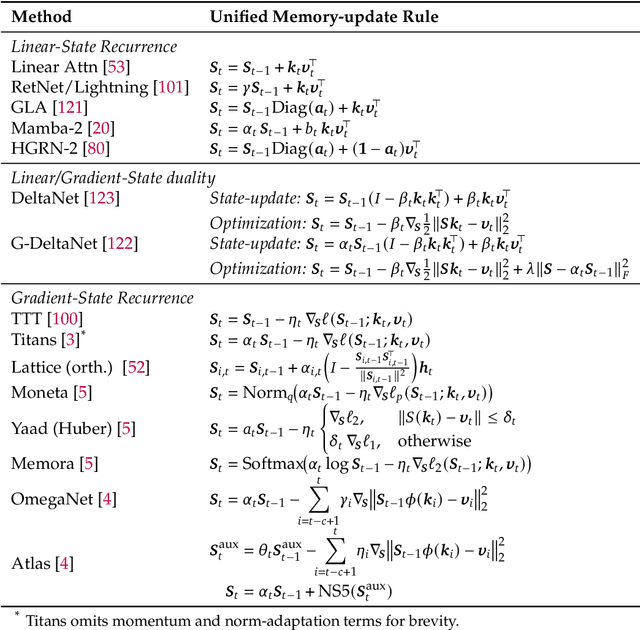
Abstract:Large Language Models (LLMs) have demonstrated impressive reasoning capabilities, especially when guided by explicit chain-of-thought (CoT) reasoning that verbalizes intermediate steps. While CoT improves both interpretability and accuracy, its dependence on natural language reasoning limits the model's expressive bandwidth. Latent reasoning tackles this bottleneck by performing multi-step inference entirely in the model's continuous hidden state, eliminating token-level supervision. To advance latent reasoning research, this survey provides a comprehensive overview of the emerging field of latent reasoning. We begin by examining the foundational role of neural network layers as the computational substrate for reasoning, highlighting how hierarchical representations support complex transformations. Next, we explore diverse latent reasoning methodologies, including activation-based recurrence, hidden state propagation, and fine-tuning strategies that compress or internalize explicit reasoning traces. Finally, we discuss advanced paradigms such as infinite-depth latent reasoning via masked diffusion models, which enable globally consistent and reversible reasoning processes. By unifying these perspectives, we aim to clarify the conceptual landscape of latent reasoning and chart future directions for research at the frontier of LLM cognition. An associated GitHub repository collecting the latest papers and repos is available at: https://github.com/multimodal-art-projection/LatentCoT-Horizon/.
Agent KB: Leveraging Cross-Domain Experience for Agentic Problem Solving
Jul 08, 2025Abstract:As language agents tackle increasingly complex tasks, they struggle with effective error correction and experience reuse across domains. We introduce Agent KB, a hierarchical experience framework that enables complex agentic problem solving via a novel Reason-Retrieve-Refine pipeline. Agent KB addresses a core limitation: agents traditionally cannot learn from each other's experiences. By capturing both high-level strategies and detailed execution logs, Agent KB creates a shared knowledge base that enables cross-agent knowledge transfer. Evaluated on the GAIA benchmark, Agent KB improves success rates by up to 16.28 percentage points. On the most challenging tasks, Claude-3 improves from 38.46% to 57.69%, while GPT-4 improves from 53.49% to 73.26% on intermediate tasks. On SWE-bench code repair, Agent KB enables Claude-3 to improve from 41.33% to 53.33%. Our results suggest that Agent KB provides a modular, framework-agnostic infrastructure for enabling agents to learn from past experiences and generalize successful strategies to new tasks.
 Add to Chrome
Add to Chrome Add to Firefox
Add to Firefox Add to Edge
Add to Edge